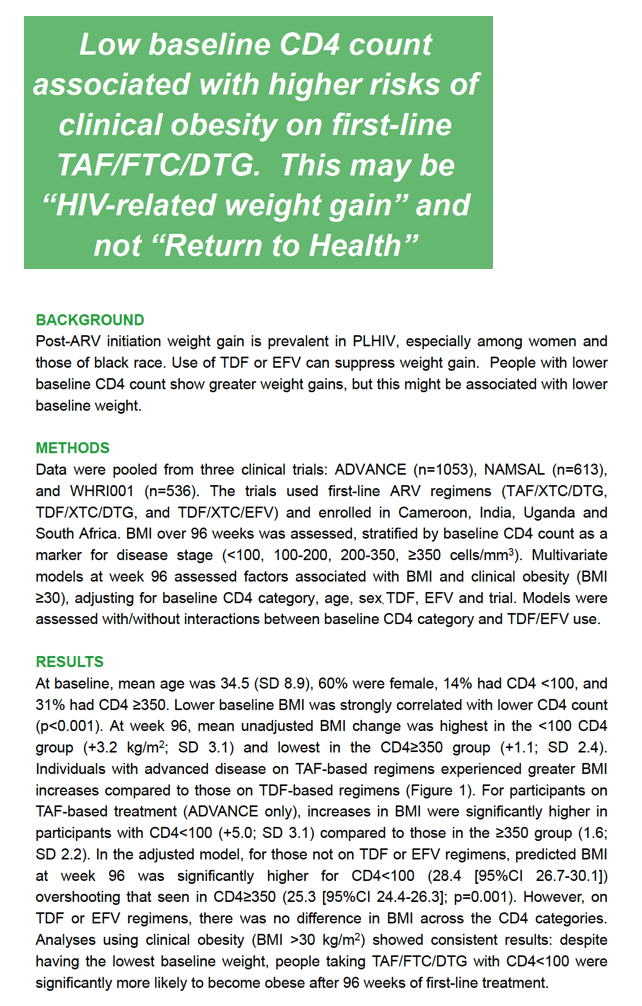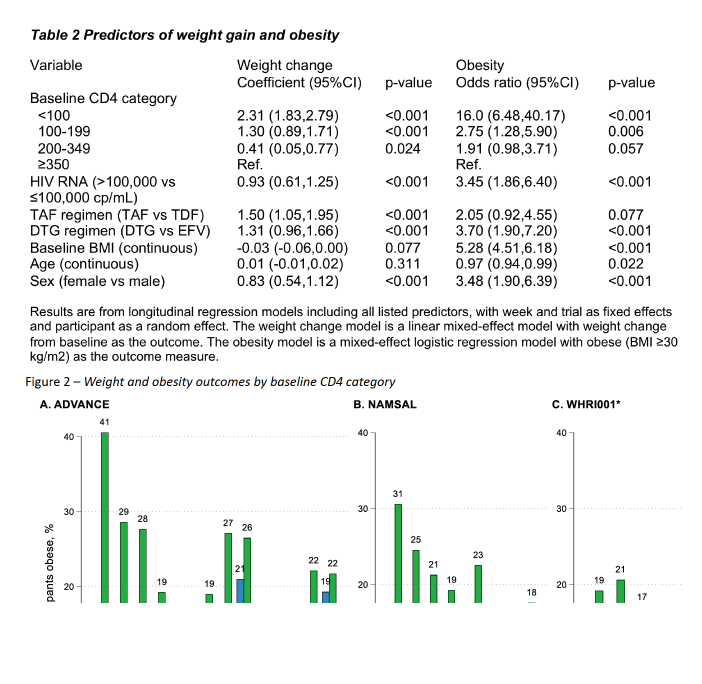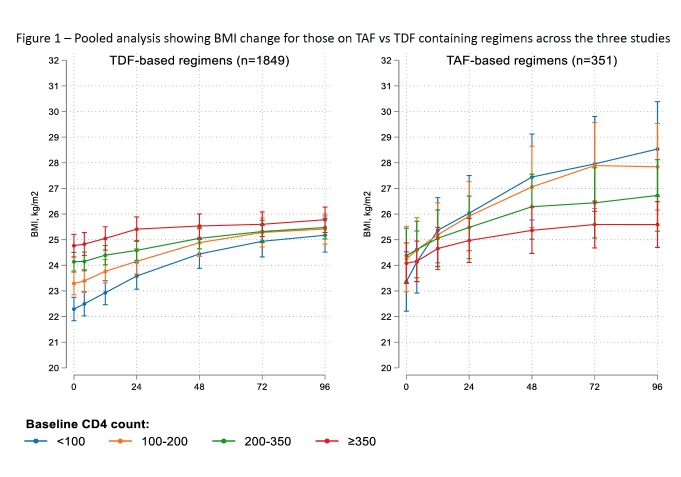 |
 |
 |
| |
Predictors of weight gain in the ADVANCE,
NAMSAL and WRHI trials; EFV, TDF, and baseline CD4 count
|
| |
| |
Lower pre-ART CD4 Count Tied to Weight Gain on DTG/TAF/FTC
CROI 2024 (Conference on Retroviruses and Opportunistic Infections), March 3-6, 2024, Denver
Mark Mascolini
People with lower CD4 counts when they started antiretroviral therapy (ART) with dolutegravir (DTG), tenofovir alafenamide (TAF), and emtricitabine (FTC) in 3 large trials in Africa and India ran a greater risk of obesity than people with higher pre-ART CD4 counts [1]. “This may be ‘HIV-related weight gain’ and not ‘return to health’” with ART, proposed Andrew Hill (University of Liverpool) and colleagues from other centers.
Gaining weight after starting ART remains highly prevalent but incompletely understood. Especially frequent among women and people of black race, first-ART weight gain poses a threat of clinical obesity. Tenofovir disoproxil (TDF) and efavirenz (EFV) suppress weight gain, but research links TAF and integrase inhibitors to adding weight.
To understand these phenomena better, Hill and colleagues pooled data from 1053 people in the ADVANCE trial [2], 613 in NAMSAL [3], and 536 in WHRI001. First-line regimens in these trials were TAF, 3TC or FTC (XTC), plus DTG; TDF, XTC, and DTG; and TDF, XTC, and EFV. The trials recruited people in Cameroon, India, Uganda, and South Africa. Participants stratified by pre-ART CD4 count (under 100, 100 to 200, 200 to 350, and 350 or higher) had their body mass index (BMI) measured through 96 weeks. Multivariate models adjusted for pre-ART CD4 category, age, sex, TDF, EFV, and trial determined factors associated with BMI above 30 kg/m2 (obesity) at week 96.
The three trials took place between July 2012 and August 2019. Altogether ADVANCE, NAMSAL, and WHRI001included 2202 people. Participants in these 3 studies did not differ much in age (median 33 years overall), proportion of females (60%), median pretreatment BMI (23 kg/m2), and proportion obese (10%). Median pre-ART CD4 count stood at 293 in ADVANCE, 281 in NAMSAL, and 205 in WHRI001, and 14% overall had a pre-ART CD4 count below 100.
Lower pretreatment BMI correlated with lower CD4 count (P < 0.001). After 96 weeks of treatment, unadjusted average BMI rose most in people with a sub-100 CD4 count before starting therapy (+3.2 kg/m2) and least in the group with a baseline CD4 count above 350 (+1.1 kg/m2).
A mixed-effects logistic regression model with obesity (BMI at or above 30 kg/m2) as the outcome measure determined that, compared with a pre-ART CD4 count above 350, each lower pre-ART CD4 stratum predicted higher odds of obesity after 96 weeks of treatment. Starting ART with a CD4 count below 100 inflated odds of obesity 16-fold:
Odds of obesity
- 200 to 349 CD4s: odds ratio (OR) 1.91, 95% CI 0.98 to 3.71, P = 0.057
- 100 to 200 CD4s: OR 2.75, 95% CI 1.28 to 5.90, P = 0.006
- Under 100 CD4s: OR 16.0, 95% CI 6.48 to 40.17, P < 0.001
Although people starting TAF/FTC/DTG had the lowest pre-ART weight, those with a CD4 count below 100 had significantly higher odds of obesity at week 96.
This analysis also linked a pre-ART viral load above versus below 100,000 copies to more than tripled odds of obesity at 96 weeks (OR 3.45, 95% CI 1.86 to 6.40, P < 0.001).Taking a TAF regimen rather than a TDF regimen nudged up odds of week-96 obesity 2-fold, but that association stopped short of statistical significance (OR 2.05, 95% CI 0.92 to 4.55, P = 0.077). Taking DTG rather than EFV boosted odds of obesity 3.7-fold (OR 3.70, 95% CI 1.90 to 7.20, P < 0.001). Female trial participants had greater than tripled odds of obesity than male participants (OR 3.48, 95% CI 1.90 to 6.39, P < 0.001).
“If weight gain on treatment was a ‘Return to Health,’” Andrew Hill argued in an email to NATAP, “we would expect people to reach a similar weight on treatment, regardless of their baseline CD4.” In fact, people starting ART with fewer than 200 CD4s, and especially fewer than 100 CD4s, ran the greatest risk of clinical obesity.
Hill and coworkers urged clinician colleagues to make weight management part of their antiretroviral treatment plans, particularly in people with low CD4 counts.
Reference
1. Hill A, Simmons B, Venter F, et al. Predictors of weight gain in the ADVANCE, NAMSAL and WRHI trials; EFV, TDF, and baseline CD4 count. CROI 2024 (Conference on Retroviruses and Opportunistic Infections), March 3-6, 2024, Denver. Abstract 808.
2. Venter WDF, Moorhouse M, Sokhela S, et al. Dolutegravir plus two different prodrugs of tenofovir to treat HIV. N Engl J Med. 2019;381:803–15. 10.1056/NEJMoa1902824. https://www.nejm.org/doi/10.1056/NEJMoa1902824
3. NAMSAL ANRS 122313 Study Group. Dolutegravir-based or low-dose regimen for the treatment of HIV-1. N Engl J Med. 2019;381:816-826. DOI 10.1056/NEJMoa1904340. https://www.nejm.org/doi/full/10.1056/NEJMoa1904340






|
| |
|
 |
 |
|
|